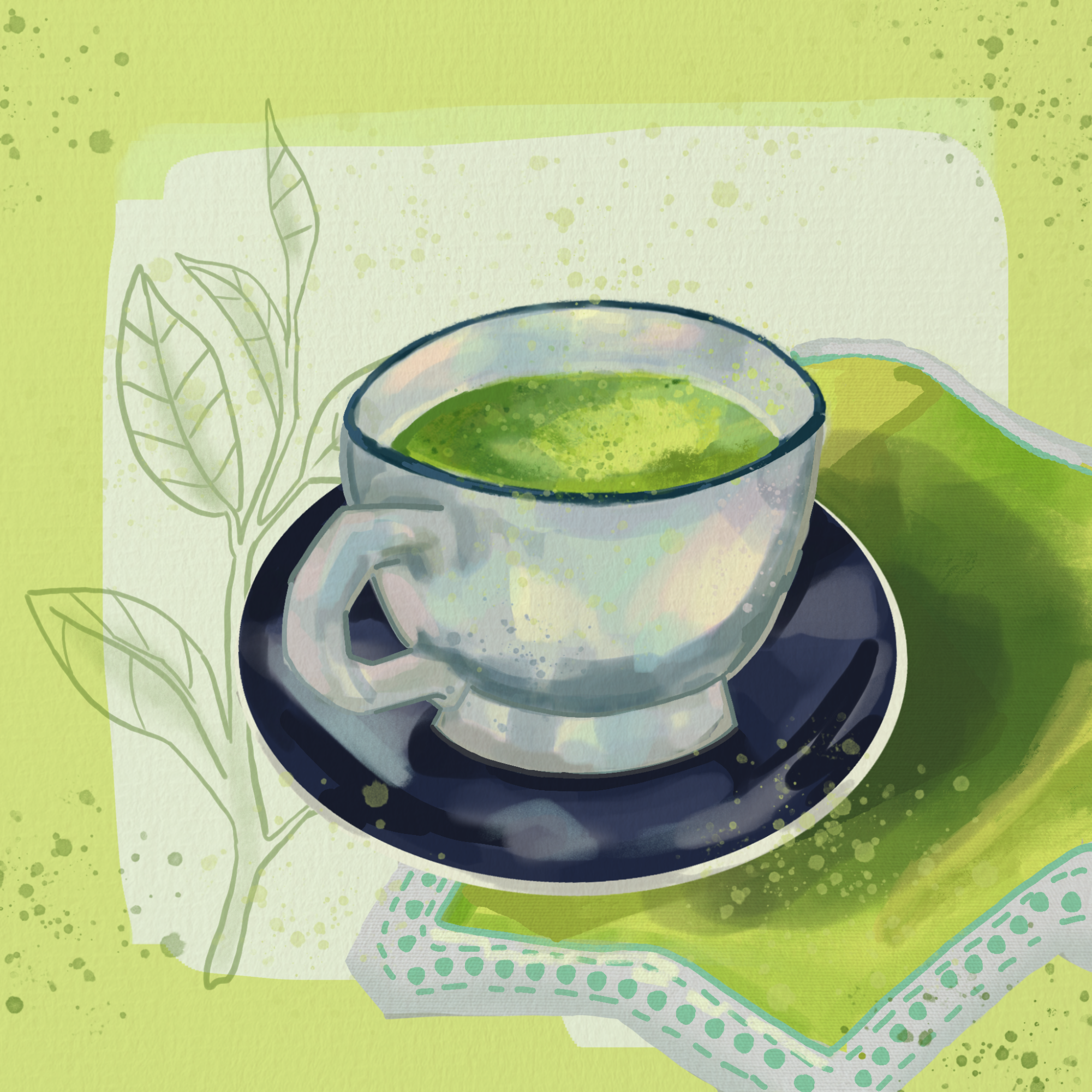As an avid matcha consumer, I was horrified to find that there’s actually a shortage of matcha worldwide! I mean, it makes sense, though, since last year, the drink basically went viral.
Nonetheless, matcha itself is so much more than just some viral social media trend; it is a significant part of Japanese culture. With a history dating back almost a thousand years, the green delicacy originated in China and was brought over to Japan by Buddhist monks.
So, what is matcha?
Matcha (抹茶) is a type of powdered green tea, made from ground Camellia sinensis leaves, that has a unique, non-bitter taste and a bright green appearance. Even though it is a green tea, matcha’s earthy umami flavor sets it apart from other teas, catapulting the beverage into a worldwide success.
According to Long Beach State University, matcha tends to evoke calmness and improve one’s ability to focus, as well as various ceremonial and religious practices. For example, matcha is used in the Japanese Tea Ceremony, or “Chanoyu” (茶の湯).
Chanoyu is a secular practice in which tea-drinking occurs in a special and intimate space. Preparing and drinking the matcha is a highly choreographed process that one studies for years in order to master it. Basically, four or five people commence the ceremony in a hermit’s hut, surrounded by a garden, thus isolating themselves from the rest of the world. The purpose of the Japanese tea ceremony is to find inner peace through the creation of a bond between the ceremony host and guests.
How did this religious drink go viral?
With around 720,000 TikTok videos under #matcha, the drink has become a viral sensation due to its unique flavor, fascinating history, and health benefits. What was once used in a simple green tea is now incorporated into a wide range of drinks and pastries, from iced lattes and energy drinks to pancakes and mousse. As of July 2024, the value of the global matcha market was predicted to jump from 2.3 billion USD to 2.9 billion USD in 2028, according to The Guardian. Moreover, the market size will grow from 3.84 billion USD in 2024 to 4.24 billion USD in 2025 at a compound annual growth rate of 10.3%, according to The Business Research Company.
With this widespread success, people have even been fusing matcha with other cultures, uniting communities that may not have ancestral ties to the Camellia sinensis. The most recent TikTok matcha trend involves adding Japanese green tea to “Dubai chocolate.” According to Megan Schaltegger, a writer for Delish, the original Dubai chocolate is made from a pistachio filling and knafeh (كنافة), a traditional Middle Eastern treat made from phyllo strands. The viral Starbucks version, however, is a Grande Iced Matcha Latte with two pumps of pistachio flavor, topped with chocolate cold foam.
Though originally not expecting much, Schaltegger was “so pleasantly surprised by the sweet and smooth matcha-pistachio combo… the chocolate cold foam added a creamy finish that wasn’t overpowering, but rather, added real depth to the overall flavor profile.”
It makes sense now–
Matcha is quite literally the perfect ingredient, hence why so many people consume and drink the product. In light of this newfound fame, however, retailers around the world observe that the supply of matcha cannot meet its demand. According to the NY Post, “signs plastered to supermarket shelves warn customers that it is very difficult to acquire matcha…In one store, too much product was sold this year, and they will not have any in stock until the new harvest in June 2025…”
Though TikTok has made the tea viral, content creators face backlash for their excessive use of the product, with users even claiming that they “will never forgive TikTok” for making the drink mainstream.
Will DeBernardis, WHS junior, states that “the problem is that we are kind of eradicating the cultural traditions of matcha. We, as consumers, do not understand where it comes from and what it symbolizes. I mean it is kind of a trend right now where many people post about it online, about the best latte ratio or useless information about Kyoto.”
I completely agree with Will. I mean, loading dozens of matcha cans from Kyoto and Tokyo into suitcases as a tourist is a bit excessive and just shows how little we actually understand about the drink’s cultural significance. Moreover, these tea leaves are only harvested once a year, within a time frame of two months for each harvest. There simply isn’t enough supply or time to meet the global demand for matcha. In addition, this overconsumption “creates an obstacle for tea ceremony practitioners,” encroaching on the sacred rituals of Japanese people.
Not to mention, new startups are completely straying away from traditional manufacturing practices concerning matcha. For instance, Poda strays away from the traditional powdered matcha, transforming it into a paste. Poda claims to “lock in [matcha’s] freshness from the moment it’s harvested. No air. No light. Just the purest, boldest matcha, preserved in its most vibrant form.” Nevertheless, the brand has faced immense backlash online for advertising matcha as a product that needs improvement.
In response to an advertisement by Poda’s founder, Mujtaba Waseem, Joe Lee, a Vancouver-based cafe owner who specializes in matcha, criticizes some of Waseem’s comments regarding Japanese tea traditions, stating, “I’m all for product innovation and trying something different. But when you call certain tools people have been using in tea ceremonies for centuries ‘crap’, it comes off a little tone deaf.” Though Waseem publicly apologized for the controversy, the disrespect and primary incentive for profit further reinforce why the mass consumerism of matcha is such a huge problem in the first place.
How can we as consumers do better?
The Global Japanese Tea Association encourages mindful consumption, where tea drinkers cherish matcha, especially if they’re buying high-quality or ceremonial grade tea. Luckily, there are certain measures in place to help mitigate the effects of the shortage and cultural appropriation in general. For example, the Japanese government is offering new subsidies to help tea growers focus on manufacturing more matcha to lessen shortages moving forward.
In essence, just be mindful. Behind every lush green latte is a sacred tradition and fragile supply chain. It’s become very easy to just sip without thinking. But maybe, next time, we should ask ourselves whether we’re drinking it or draining it.




